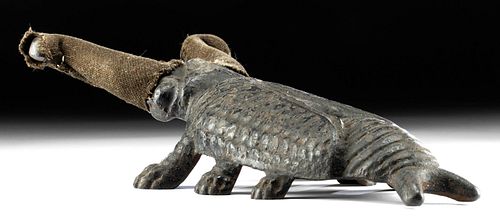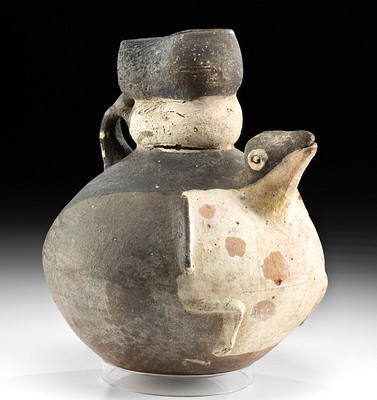19th C. Belgian Iron Boot Jack Beetle by N. Martin
Lot 58
About Seller
Artemis Gallery
686 S Taylor Ave, Ste 106
Louisville, CO 80027
United States
Selling antiquities, ancient and ethnographic art online since 1993, Artemis Gallery specializes in Classical Antiquities (Egyptian, Greek, Roman, Near Eastern), Asian, Pre-Columbian, African / Tribal / Oceanographic art. Our extensive inventory includes pottery, stone, metal, wood, glass and textil...Read more
Categories
Estimate:
$350 - $550
Absentee vs Live bid
Two ways to bid:
- Leave a max absentee bid and the platform will bid on your behalf up to your maximum bid during the live auction.
- Bid live during the auction and your bids will be submitted real-time to the auctioneer.
Bid Increments
| Price | Bid Increment |
|---|---|
| $0 | $25 |
| $300 | $50 |
| $1,000 | $100 |
| $2,000 | $250 |
| $5,000 | $500 |
| $10,000 | $1,000 |
| $20,000 | $2,500 |
| $50,000 | $5,000 |
| $100,000 | $10,000 |
| $200,000 | $20,000 |
About Auction
By Artemis Gallery
Oct 28, 2021
Set Reminder
2021-10-28 12:00:00
2021-10-28 12:00:00
America/New_York
Bidsquare
Bidsquare : Fauna, Flora, Stone & Bones - Fall Edition
https://www.bidsquare.com/auctions/artemis-gallery/fauna-flora-stone-bones---fall-edition-7768
Join us for a very special early Fall auction featuring fabulous fossils, rocks, and minerals, plus art depicting flora and fauna from antiquity to present day. This is one sale you won't want to miss! Artemis Gallery info@artemisgallery.com
Join us for a very special early Fall auction featuring fabulous fossils, rocks, and minerals, plus art depicting flora and fauna from antiquity to present day. This is one sale you won't want to miss! Artemis Gallery info@artemisgallery.com
- Lot Description
Western Europe, Belgium, Huy, ca. 19th to early 20th century CE. A fantastical boot jack cast from iron in the form of a large beetle that rests upon 6 legs that resemble lion paws! The wings are slightly parted to reveal the segmented abdomen and posterior pincers; the head is slightly elevated with long antennae or giant pincers that form the jack. Both antennae are covered with a thick brown fabric, perhaps to protect the iron surface; despite the humble purpose, this is a work of art! The concave underside is engraved with the maker mark "MARTIN / A / HUY/ 1266.” Nestor Martin (1825-1916) established an iron foundry in Huy, Belgium in 1854, specializing in transforming domestic objects, coal bins, umbrella stands, and utilitarian items into fantastical pieces! He was influenced by the Art Nouveau movement and awarded prizes at exhibitions for his creative work. After his death, the Martin company grew and expanded globally and by 1930 Martin was well known for producing high end appliances, such as stoves and furnaces. Size: 11.75" L x 5" W (29.8 cm x 12.7 cm)
Provenance: private Lake City, Colorado, USA collection, acquired in 2021
All items legal to buy/sell under U.S. Statute covering cultural patrimony Code 2600, CHAPTER 14, and are guaranteed to be as described or your money back.
A Certificate of Authenticity will accompany all winning bids.
PLEASE NOTE: Due to recent increases of shipments being seized by Australian & German customs (even for items with pre-UNESCO provenance), we will no longer ship most antiquities and ancient Chinese art to Australia & Germany. For categories of items that are acceptable to ship to Australia or Germany, please contact us directly or work with your local customs brokerage firm.
Display stands not described as included/custom in the item description are for photography purposes only and will not be included with the item upon shipping.
#164813Excellent condition. Intact. Russet patina on underside. Surface abrasions as expected with use and age. The fabric on the antennae is worn, with tearing and fraying from use, and not original to the piece but likely an older addition and shows signs of age. Maker mark is clearly signed on underside.Condition
- Shipping Info
-
All shipping is handled in-house for your convenience. Your invoice from Artemis Gallery will include shipping calculation instructions. If in doubt, please inquire BEFORE bidding for estimated shipping costs for individual items.
-
- Buyer's Premium



 EUR
EUR CAD
CAD AUD
AUD GBP
GBP MXN
MXN HKD
HKD CNY
CNY MYR
MYR SEK
SEK SGD
SGD CHF
CHF THB
THB















